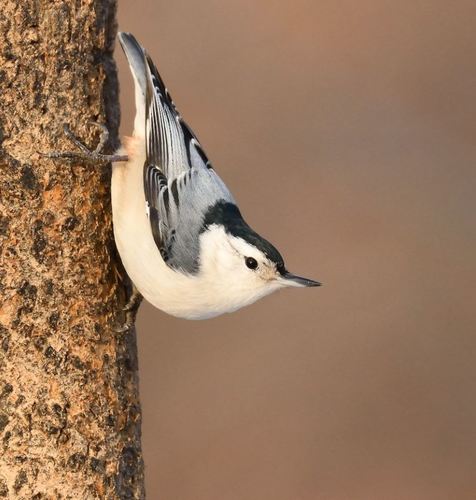
White-breasted Nuthatch
The White-breasted Nuthatch (Sitta carolinensis) is a small, energetic songbird common throughout North America. Known for its distinctive habit of creeping headfirst down tree trunks, this nuthatch plays a vital role in controlling insect populations. It's a familiar sight at backyard feeders and in woodlands, often recognized by its sharp, nasal calls. While not globally threatened, it faces localized challenges due to habitat loss, making it a species of interest for conservation monitoring. The bird does not hold significant cultural status, but its unique upside-down feeding behavior makes it recognizable.
13-15 cm
Length
20-27 cm
Wingspan
Least Concern
Conservation Status
Distribution
Found across North America, from southern Canada through the United States and into parts of Mexico. Generally non-migratory, though some northern populations may move short distances south in winter. Occurs at low to moderate elevations, rarely found in high mountains.
Lifespan
Average lifespan in the wild is about 2 years, but can reach up to 10 years.
White-breasted Nuthatch's Habitat
Habitat Types
Deciduous forests, Mixed woodlands, Parks, Suburban areas with mature trees
Climate Zones
Temperate, Subtropical
Adaptations
Strong legs and toes, along with a long, sharp claw on the hind toe (hallux), allow it to grip bark and move in any direction, including headfirst down tree trunks. A relatively long, straight bill is adapted for probing into crevices.
Variations
Several subspecies are recognized, differing slightly in size, bill length, and plumage coloration. For example, western populations tend to have darker backs than eastern ones.
Appearance
Breeding Plumage
Plumage remains relatively constant throughout the year.
Seasonal Feather Changes
No significant seasonal variation.
Sex Based Plumage Differences
Males typically have a black cap, while females have a gray or dark gray cap. The back is blue-gray, and the underparts are white.
Notable Features
White face and underparts, Black or gray cap contrasting with white cheeks, Blue-gray back, Short tail
Diet and Feeding
Primary Foods
Insects, Spiders, Seeds, Nuts
Foraging Behavior
Forages primarily on tree trunks and branches, probing bark crevices for insects and spiders. Also gleans insects from foliage and occasionally catches insects in flight. Will readily visit bird feeders, especially for sunflower seeds and suet.
Specializations
Strong, sharp bill for probing bark. Ability to move headfirst down trees allows access to food sources unavailable to many other birds.
Seasonal Diet Variations
Diet shifts with seasonal availability. Insects and spiders are dominant in the warmer months, while seeds and nuts become more important in winter.
Behavior
Social Structure
Generally found in pairs or family groups. Not typically found in large flocks, but may join mixed-species foraging flocks in winter.
Communication
A rapid, nasal 'yank-yank-yank' call, A variety of other chattering and squeaking sounds, Visual displays, such as tail spreading and wing drooping
Migration
Mostly non-migratory, but some northern populations may move short distances south in winter. These movements are often irregular and dependent on food availability.
Territorial or Group Behaviors
Territorial during the breeding season, defending the area around their nest site. Pairs may remain on their territory year-round.
Conservation
Threats
Habitat loss due to deforestation and urbanization, Loss of mature trees with suitable nesting cavities, Competition with invasive species, such as European Starlings, for nest sites
Protection Programs
Habitat conservation and restoration efforts, Provision of artificial nest boxes
Local National Laws
Protected under the Migratory Bird Treaty Act in the United States.
Population Trend
Stable
Population Estimates
Global population estimated to be around 9.8 million.
Interesting Facts
They often store food in bark crevices.
This behavior, called caching, helps them survive during periods of food scarcity, especially in winter.
They can move in any direction on tree trunks.
Their strong legs and claws allow them to climb up, down, and sideways with equal ease.
They sometimes use tools.
They have been observed using pieces of bark to pry up other bark flakes in search of insects.
Faqs about White-breasted Nuthatch
What do White-breasted Nuthatches eat?
They eat a mix of insects, spiders, seeds, and nuts. Their diet changes with the seasons.
Where do White-breasted Nuthatches nest?
They nest in tree cavities, either natural ones or old woodpecker holes.
Are White-breasted Nuthatches migratory?
Most are non-migratory, but some northern populations may move short distances south in winter.
How can I attract White-breasted Nuthatches to my yard?
Provide a source of food, such as sunflower seeds, suet, and peanuts, in a bird feeder. Having mature trees in your yard can also help attract them.
Copyright @ Nature Style Limited. All Rights Reserved.
 English
English